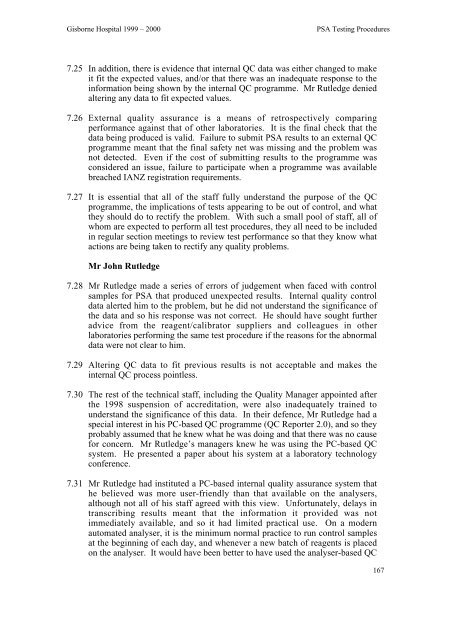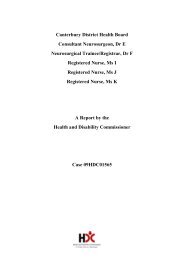Gisborne Hospital Report - Health and Disability Commissioner
Gisborne Hospital Report - Health and Disability Commissioner
Gisborne Hospital Report - Health and Disability Commissioner
Create successful ePaper yourself
Turn your PDF publications into a flip-book with our unique Google optimized e-Paper software.
<strong>Gisborne</strong> <strong>Hospital</strong> 1999 – 2000<br />
PSA Testing Procedures<br />
7.25 In addition, there is evidence that internal QC data was either changed to make<br />
it fit the expected values, <strong>and</strong>/or that there was an inadequate response to the<br />
information being shown by the internal QC programme. Mr Rutledge denied<br />
altering any data to fit expected values.<br />
7.26 External quality assurance is a means of retrospectively comparing<br />
performance against that of other laboratories. It is the final check that the<br />
data being produced is valid. Failure to submit PSA results to an external QC<br />
programme meant that the final safety net was missing <strong>and</strong> the problem was<br />
not detected. Even if the cost of submitting results to the programme was<br />
considered an issue, failure to participate when a programme was available<br />
breached IANZ registration requirements.<br />
7.27 It is essential that all of the staff fully underst<strong>and</strong> the purpose of the QC<br />
programme, the implications of tests appearing to be out of control, <strong>and</strong> what<br />
they should do to rectify the problem. With such a small pool of staff, all of<br />
whom are expected to perform all test procedures, they all need to be included<br />
in regular section meetings to review test performance so that they know what<br />
actions are being taken to rectify any quality problems.<br />
Mr John Rutledge<br />
7.28 Mr Rutledge made a series of errors of judgement when faced with control<br />
samples for PSA that produced unexpected results. Internal quality control<br />
data alerted him to the problem, but he did not underst<strong>and</strong> the significance of<br />
the data <strong>and</strong> so his response was not correct. He should have sought further<br />
advice from the reagent/calibrator suppliers <strong>and</strong> colleagues in other<br />
laboratories performing the same test procedure if the reasons for the abnormal<br />
data were not clear to him.<br />
7.29 Altering QC data to fit previous results is not acceptable <strong>and</strong> makes the<br />
internal QC process pointless.<br />
7.30 The rest of the technical staff, including the Quality Manager appointed after<br />
the 1998 suspension of accreditation, were also inadequately trained to<br />
underst<strong>and</strong> the significance of this data. In their defence, Mr Rutledge had a<br />
special interest in his PC-based QC programme (QC <strong>Report</strong>er 2.0), <strong>and</strong> so they<br />
probably assumed that he knew what he was doing <strong>and</strong> that there was no cause<br />
for concern. Mr Rutledge’s managers knew he was using the PC-based QC<br />
system. He presented a paper about his system at a laboratory technology<br />
conference.<br />
7.31 Mr Rutledge had instituted a PC-based internal quality assurance system that<br />
he believed was more user-friendly than that available on the analysers,<br />
although not all of his staff agreed with this view. Unfortunately, delays in<br />
transcribing results meant that the information it provided was not<br />
immediately available, <strong>and</strong> so it had limited practical use. On a modern<br />
automated analyser, it is the minimum normal practice to run control samples<br />
at the beginning of each day, <strong>and</strong> whenever a new batch of reagents is placed<br />
on the analyser. It would have been better to have used the analyser-based QC<br />
167
















